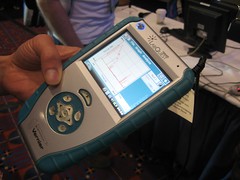OSCON, Pt. 1.1: Free-Range Open Source
Yesterday I left behind the muggy July of New York to drink in the relative cool of Portland, Ore. -- and also to drink in a week of the open source world, courtesy of O'Reilly's <a href="http://en.oreilly.com/oscon2008/" target="_blank">OSCON</a>.</p>

Yesterday I left behind the muggy July of New York to drink in the relative cool of Portland, Ore. -- and also to drink in a week of the open source world, courtesy of O'Reilly's OSCON.
O'Reilly knows how to treat their guests. Not only was the registration process wonderfully painless (+1 points), not only was there wireless throughout the convention center (+3 points), the tables in the lecture halls had power strips (+5). My notebook gets around 4-5 hours of battery life, but not having to run out of juice in the middle of a lecture is a huge help. (The giant Buddhist temple bell outside the convention center that rings "without warning" was another nice bonus.)
With the exhibitor's hall not yet open -- that's tomorrow -- I elected to check out the "Open Mobile Exchange", a set of quick lectures from various movers and shakers in the open source mobile communications field. Representatives from OpenMoko and Android were invited, but couldn't make it due to scheduling conflicts -- a shame, since both of them would have had plenty to say about the goings-on.
Jim Zemlin of the Linux Foundation kicked off with words of encouragement for mobile open source developers: "You use Linux every day and you might not even know it." According to his stats, Linux is the fastest-growing mobile platform out there, and also is consolidating strongly in the embedded market thanks to a broad range of software running on Linux (it's software that drives this market, he asserted, not new hardware devices). The flexibility of the Linux stack and its business advantages were other major assets; the rising value of mobile applications, easier branding opportunities (your own Linux, not someone else's proprietary OS), and the consolidation of Linux as a platform also figured into the picture.
One interesting consolidation tidbit: Jim claimed that many of the same innovations that allow for reducing power usage in data centers that run Linux also can help enhance battery life for mobile devices. But a major stumbling block is still licensing issues -- both of the GPLv2 to v3 variety, and the more conventional lack of understanding of OSS licenses.
Cloud Four's "Going Fast on the Mobile Web" talked about how Web developers in the West aren't ready for a forthcoming surge in Web content delivered to mobile devices. The number of devices isn't the issue; it's the usage those devices permit -- which is why the iPhone has a far greater percentage of Web-surfing going on vs. the BlackBerry, despite the disparity in units sold. If open source communities don't focus on ease of use or programmable access to device characteristics (like device orientation, something the iPhone has), we're looking at a whole new kind of browser war. Ugh. (For fun, point your mobile browser at their Mobile Browser Concurrency Test to see what capabilities your mobile device's Web browser does and doesn't support. You might be unpleasantly surprised by the results.)
Funambol talked about "Leveraging Mobile Open Source For New Wireless Apps And Services" -- essentially talking about strategies open source solutions could take in said markets. Two basic revenue models seem to be in prevalence here: the "free razor/pay for the blades" model, or the ad-driven model. The former is where the user's own content is what's monetized (e.g., Flickr's free basic storage vs. a for-pay tier); the latter is what Google does, and probably plans to do even more of once Android is kicked off. Fragmentation in the platform market is a major problem for reasons not always clear -- you can't easily deliver open source solutions for the BlackBerry, for instance, since every app that runs there has to be code-signed.
Jennifer Minor of Vernier gave us "Handwave to Hardware", a primer on how to build a Linux-powered device. Vernier's forte is equipment for scientific and educational use. Its LabQuest is a ruggedized little data-collection system that can be connected to a PC or run as a standalone unit. They used GTK and QEMU, with the latter being the device emulator they used to perform the debugging. The whole thing kicked off in March 2006 and went to market in September 2007, and has sold 25,000 units since.

The folks from Zembly showed off their Website, a collaborative way to create social apps for Facebook, MySpace, or the iPhone. They characterized it as a kind of Wikipedia for live code, and demoed an iPhone app (emulated in the Web browser) to locate London tube stations, with Google providing the map data. By doing this kind of development in public, or so goes the thesis, one can leverage crowdsourcing in an immediate way -- the apps run and can be modified right in front of you, regardless of your own platform.
Finally, David "Lefty" Schlesinger of LiMo delivered a session on "LiMo Practicals" -- how the LiMo stack (in their humble opinion) stands to be one of the best weapons for the war to win the mobile market. In one of the session's most hilarious and cutting moments, he compared the Power Mac G4 with a Nokia N95 phone; the phone came out ahead (well, maybe except in terms of display size). He also emphasized how open source that already has a community of users and developers (i.e., LiMo itself) has a better shot of commanding the mobile marker than cultures where openness is simply not there (Apple) or where its value is still not well-established (Google/Android).
I'll be reporting back through the week with more about other sessions and sit-downs. Tomorrow: Microsoft talks open source, along with a whole roundtable of other folks.
About the Author(s)
You May Also Like








